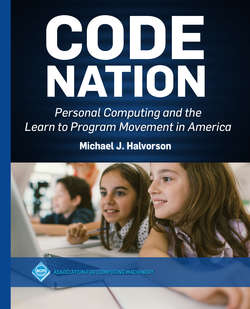Читать книгу Code Nation - Michael J. Halvorson - Страница 10
На сайте Литреса книга снята с продажи.
1.1Programming Programmingculture Culture
ОглавлениеThis book is about the rise of computer programmers and the emerging social, technical, and commercial worldview that I call programming culture, which took a distinctive form during the early decades of microcomputers and personal computing, c. 1970–1995. It is a popular history of coding that explores the experiences of novice computer users, tinkerers, hackers, and power users, as well as the ideals and aspirations of computer scientists, educators, engineers, and entrepreneurs. A central part of this story is the Learn-to-program movement learn-to-program movement, which germinated in government and university labs during the 1950s, gained momentum through counterculture experiments in the 1960s and early 1970s, became a broad-based educational agenda in the late 1970s and early 1980s, and was transformed by commercialization practices in the 1990s and 2000s. The learn-to-program movement sought to make computers more understandable, imprint useful technical skills, establish shared values, build virtual communities, and offer economic opportunities for technology enthusiasts. The movement also supported user communities, schools, and emerging commercial industries, many of which benefited from the utility and connectivity provided by digital electronic computers.
The learn-to-program movement had its ups and downs, but eventually set the stage for 21st century expressions of computational literacy, such as the Hour of Code Hour of Code, YouTube YouTube and Lynda courseware Lynda courseware, Certification programs certification programs, Coding boot camps coding boot camps, and University degrees in disciplines university degrees in disciplines such as Computer science computer science, Software engineering software engineering, Information technology information technology, Artificial intelligence (AI) artificial intelligence, and (most recently) Human–computer interaction human–computer interaction. As the title of this book suggests, the learn-to-program movement fostered a groundswell of popular support for computing culture in America, resulting in what I call a Code Nation—a globally-connected society that is saturated with computer technology and enchanted by software and its creation.
The learn-to-program movement (or more broadly, the software-maker movement) has inspired both disciples and critics. It has evolved over time and its advocates have traversed numerous professional boundaries and cultural institutions. The movement is historically distinct but also follows the patterns and rhythms of earlier socio-technical transformations, including the introduction of Steam-powered technologies steam-powered technologies during the Industrial Revolution, the electrification of American businesses and homes, and the production of automobiles and “car culture” in the early 20th century.
Borrowing terminology from information science and the history of technology, the learn-to-program movement is identifiable as part of the “diffusion” and “domestication” phases that take place when a successful new technology is spread or “propagated” across society.2 Scholars from the field of business and economic history also recognize this transition as a key period in which a new discovery or invention is widely adopted and made useful for the general public, resulting in new consumer behaviors and potential changes in the way that a market or the broader economy functions.3 To achieve wide-spread diffusion, the movement often benefits from sustaining ideologies that strengthen the allegiance of followers and justify the time, resources, and commitment that are necessary for the movement’s success.
Beyond hopes for material gain, America’s expanding programming culture can also be viewed as a manifestation of the deep and abiding cultural tendency that many describe as “technological enthusiasm.”4 Technological enthusiasm Technological enthusiasm is an upbeat, optimistic appraisal of new technical systems that not only stoke the engines of capitalism, but provide access to the ideals embedded in what is known as the American Project American Project and the American Dream American Dream. The publishers of PC software systems readily participated in this vision, as each wave of entrepreneur–engineer strived to improve their software, best their rivals, and boost the productivity of corporations and the general public. By the 1980s, software creation had taken the form of a consensus ideology that united many Americans in a common, accessible dream of a better future through computing. As I will discuss in Chapter 2, this enthusiasm brought additional computing mythologies to the fore, and their collective use contributed to the positive view that American’s held about PCs and software in the years to come. Formula translation (FORTRAN)
